Introduction to Ha Long Bay
A UNESCO world heritage site and truly a natural wonder – Halong Bay is made up of over 3000 limestone karsts that soar skyward out of calm emerald waters. Within the islands of the Bay there are hundreds of beautiful caves, including many famous names such as Thien Cung, Dau Go, Sung Sot, Tam Cung and Bo Nau. Some of them are archaeological sites retaining tangible archaeological evidence of Soi Nhu and Ha Long prehistoric cultures such as Soi Nhu, Me Cung, Tien Ong, Thien Long, Hang Trong, and Trinh Nu caves. The name Ha Long Bay is literally translated as “Bay of Descending Dragons”. A legend has been handed down in the local area relating to the name Ha Long Bay, which says: “Long ago, in the first founding days, the Viet people were attacked by foreign aggressors. The Jade Emperor sent theMother Dragon and a herd of Child Dragons to help the Viet fight the invaders. While the enemy vessels were launching massive attacks against the mainland, the dragons descended in flocks from the sky. They spat out innumerable pearls that, in a moment, were changed into innumerable jade stone islands linked together into firm citadels that checked the enemy’s advance and smashed their vessels into pieces. The Viet won at last! After the invaders were driven out, Mother Dragon and her Child Dragons did not return to Heaven but stayed on earth, right at the place where the battle occurred. The spot where the Mother Dragon landed was Ha Long, and where the Child Dragons came down was Bai Tu Long. The place where their tails violently wagged was called Long Vi, the present-day Tra Co Peninsula with its soft sandy beach stretching dozens of kilometers”.
Sung Sot Cave
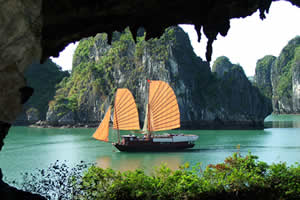
Situated in the centre of the UNESCO-declared World Heritage area, the Sung Sot or Surprise Grotto is on Bo Hon Island, and is one of the finest and widest grottoes of Ha Long Bay. ha long 2
Ascending to the grotto, the way is covered by trees and foliage, and consists of great paved stone blocks.Inside, it is artitioned into two chambers; the first one being similar to a wide theatre hall. Many stalactites hang from the high ceiling, with numerous possible forms and shapes.Anarrow passage leads to the second rooms, where a flow of light meets visitors. The chamber is so immense it could contain thousands of people at one time.At the deepest point of the grotto, a “royal garden” appears with a clear pond and a seemingly fascinating landscape of mountains. Many birds and plants (benjamin figs, cycads and centenary banyan trees) live here. On nice days groups of monkeys might arrive in search of fruit.
Thien Cung Grotto
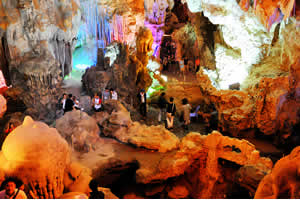 It is situated on the south-west side the bay, 4 km from the wharf outside of Ha Long City. The way to Thien Cung is a perilous one, covered on both sides by thick forest. After entering a narrow gate, the grotto’s 130-meter-long girth opens up. Getting in we are more astonished in front of the very animated and splendid beauty which is made from stalactite. On the east wall of the grotto, there is a grandiose and imposing picture with characters of tales.Going out of the Thien Cung Grotto, we have a sensation of just watching a unique, meticulous, interesting fine-art museum which is made by nature, get out of the imagine, ability and intellect of man.This grotto is recently discovered, one of the most beautiful grottoes in Ha Long Bay.Legend has it, that beautiful young lady named May (cloud), caught the eye of the Dragon Prince and he fell in love with her. They were betrothed, and their wedding lasted seven days and seven nights in the very centre of the grotto.In honour of the wedding, small dragons flew about through the stalactites and stalagmites, elephants danced together happily, snakes twined themselves around trees and two stone lions danced with their manes flowing in the wind. A large elephant, smartly dressed, waited for the bride and the groom. The genies of the south and north stars came to attend the banquet and the atmosphere were definitely animated and lively. All these scenes have been seemingly fossilized in the grotto.In the centre are four large pillars supporting the “roof of heaven.” From the base to the top, many strange images seem to live in the stone: birds, fish, flowers and even scenes of human life. On the north wall of the grotto a group of fairies seem to dance and sing in honour of the wedding. Under the immeasurably high roof, stalactites make a natural stone curtain. Somewhere there is the sound of a drum beating, but it is actually just the noise made by the wind blowing through stone.
It is situated on the south-west side the bay, 4 km from the wharf outside of Ha Long City. The way to Thien Cung is a perilous one, covered on both sides by thick forest. After entering a narrow gate, the grotto’s 130-meter-long girth opens up. Getting in we are more astonished in front of the very animated and splendid beauty which is made from stalactite. On the east wall of the grotto, there is a grandiose and imposing picture with characters of tales.Going out of the Thien Cung Grotto, we have a sensation of just watching a unique, meticulous, interesting fine-art museum which is made by nature, get out of the imagine, ability and intellect of man.This grotto is recently discovered, one of the most beautiful grottoes in Ha Long Bay.Legend has it, that beautiful young lady named May (cloud), caught the eye of the Dragon Prince and he fell in love with her. They were betrothed, and their wedding lasted seven days and seven nights in the very centre of the grotto.In honour of the wedding, small dragons flew about through the stalactites and stalagmites, elephants danced together happily, snakes twined themselves around trees and two stone lions danced with their manes flowing in the wind. A large elephant, smartly dressed, waited for the bride and the groom. The genies of the south and north stars came to attend the banquet and the atmosphere were definitely animated and lively. All these scenes have been seemingly fossilized in the grotto.In the centre are four large pillars supporting the “roof of heaven.” From the base to the top, many strange images seem to live in the stone: birds, fish, flowers and even scenes of human life. On the north wall of the grotto a group of fairies seem to dance and sing in honour of the wedding. Under the immeasurably high roof, stalactites make a natural stone curtain. Somewhere there is the sound of a drum beating, but it is actually just the noise made by the wind blowing through stone.
Arriving at the last partition of the grotto, a natural gushing stream of water babbles throughout the year. Here are three small ponds of clear water. Legend has it, that this was where May bathed her 100 children, bringing them up wisely and happily into adolescence. One path meanders out of the grotto; it was the way May, together with 50 of her children, took to harvest new lands. The 50 remaining children, together with their father, were left to build the native land. Left behind by the mother was the natural stream described above.
Titov Island
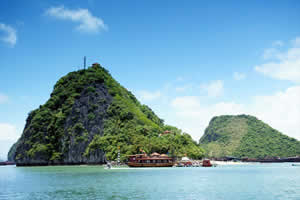 Situated about 7-8 km south-east of Bai Chay lies the small Ti Top Island. It displays a beach shaped like a crescent moon, and sand that has been washed to a snowy white by the tide. On 22 November 1962, this tiny island had the honour of receiving a visit from astronaut Ghermann Titov, a hero of the former Soviet Union, accompanied by Ho Chi Minh. To perpetuate the remembrance of their visit, Uncle Ho named the place Ti Top Island. It has now become an attractive beach for tourists and has various of tourist services.
Situated about 7-8 km south-east of Bai Chay lies the small Ti Top Island. It displays a beach shaped like a crescent moon, and sand that has been washed to a snowy white by the tide. On 22 November 1962, this tiny island had the honour of receiving a visit from astronaut Ghermann Titov, a hero of the former Soviet Union, accompanied by Ho Chi Minh. To perpetuate the remembrance of their visit, Uncle Ho named the place Ti Top Island. It has now become an attractive beach for tourists and has various of tourist services.
Am Islet
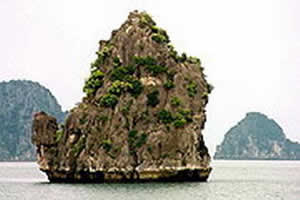 Am Rock or Kettle Islet is situated in Bai Tu Long Bay. An island jutting out of the seawaters, the teapot of the Jade Emperor, who accidentally dropped it into Ha Long so, its handle was broken.
Am Rock or Kettle Islet is situated in Bai Tu Long Bay. An island jutting out of the seawaters, the teapot of the Jade Emperor, who accidentally dropped it into Ha Long so, its handle was broken.
Con Coc Islet
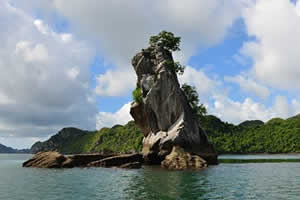 Con Coc or Toad Islet is one of the most exquisite works nature has presented Ha Long. Just imagine, a 9-meter-tall toad sitting to wait for rain amidst the vastness of the sea. The Toad Islet lies in the southeast of Ha Long Bay, 12 km away from the tourist boat wharf. The Toad is an ugly but useful animal. In the drought season, farmers usually listen to its sound to guess when it will rain. The Vietnamese have a folk tale about the hard trek of thirsty animals to Heaven to plead for rain. A tiny courageous toad led this struggle. Eventually, the Jade Emperor adopted the Toad as his Uncle and willingly creates rain whenever it grinds its teeth.
Con Coc or Toad Islet is one of the most exquisite works nature has presented Ha Long. Just imagine, a 9-meter-tall toad sitting to wait for rain amidst the vastness of the sea. The Toad Islet lies in the southeast of Ha Long Bay, 12 km away from the tourist boat wharf. The Toad is an ugly but useful animal. In the drought season, farmers usually listen to its sound to guess when it will rain. The Vietnamese have a folk tale about the hard trek of thirsty animals to Heaven to plead for rain. A tiny courageous toad led this struggle. Eventually, the Jade Emperor adopted the Toad as his Uncle and willingly creates rain whenever it grinds its teeth.
Dinh Huong Islet
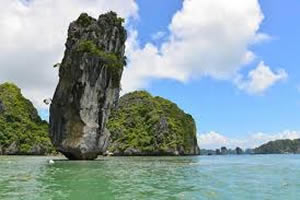 In the itinerary of Thien Cung – Dau Go – Ti Top, one finds Dinh Huong Islet or Lu Huong (Incense Burner Islet) to the southwest of Dau Go Island. Passing the Cho Da (Stone Dog) Islet and the Con Meo (Cat) Islet, one sees an imposing stone slab resting on two other small stones stands blocked the way. The stone slab resembles a huge incense burner, which lies in the middle of the sea as a holy object to worship the Sky and Earth.
In the itinerary of Thien Cung – Dau Go – Ti Top, one finds Dinh Huong Islet or Lu Huong (Incense Burner Islet) to the southwest of Dau Go Island. Passing the Cho Da (Stone Dog) Islet and the Con Meo (Cat) Islet, one sees an imposing stone slab resting on two other small stones stands blocked the way. The stone slab resembles a huge incense burner, which lies in the middle of the sea as a holy object to worship the Sky and Earth.
Trong Mai Islet
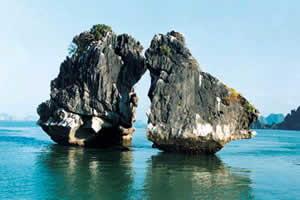 Trong Mai is situated on the south-west side of Ha Long Bay, 5 km from the tourist wharf near to Dinh Huong Islet. In a somewhat large expanse of open sea, the island seems to grow up from the bottom of the deep emerald waters. At sunset, the island with the height of over 10 m is bright red and in a somewhat tottery position. Their tiny legs support heavy bodies, and it appears that one strong wave could throw the two stone blocks into the sea. However, hundreds of millions of years have passed, and the Trong Mai is still there. The image of the island is the logo of Ha Long Bay and Vietnam Tourism.
Trong Mai is situated on the south-west side of Ha Long Bay, 5 km from the tourist wharf near to Dinh Huong Islet. In a somewhat large expanse of open sea, the island seems to grow up from the bottom of the deep emerald waters. At sunset, the island with the height of over 10 m is bright red and in a somewhat tottery position. Their tiny legs support heavy bodies, and it appears that one strong wave could throw the two stone blocks into the sea. However, hundreds of millions of years have passed, and the Trong Mai is still there. The image of the island is the logo of Ha Long Bay and Vietnam Tourism.
Oan Islet
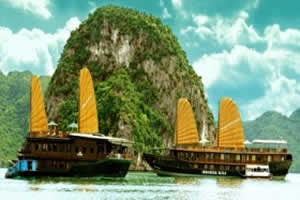 Situated 300 m away from Bai Tho Mountain and 5 km from the Bai Chay Tourist Wharf, a 22-meter islet stands out in Bai Tu Long Bay. It has the shape of truncated sticky rice, which serves as an offering to Buddha.
Situated 300 m away from Bai Tho Mountain and 5 km from the Bai Chay Tourist Wharf, a 22-meter islet stands out in Bai Tu Long Bay. It has the shape of truncated sticky rice, which serves as an offering to Buddha.
Dau Nguoi (Human head) Islet
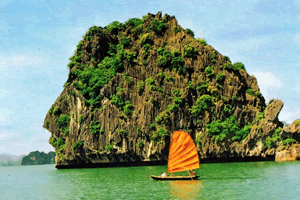 From afar, you can see a 25-meter islet, which reminds us of a huge Egyptian head with a big nose. Its chin lies close to the sea surface. Many people associate it with the image of the Egyptian Sphinx. The Dau Nguoi Islet in Ha Long Bay, a masterpiece of nature, has its own poetic beauty as it lies amidst seawaters. The islet lies near Luon Cave, 13 km away from the tourist wharf.
From afar, you can see a 25-meter islet, which reminds us of a huge Egyptian head with a big nose. Its chin lies close to the sea surface. Many people associate it with the image of the Egyptian Sphinx. The Dau Nguoi Islet in Ha Long Bay, a masterpiece of nature, has its own poetic beauty as it lies amidst seawaters. The islet lies near Luon Cave, 13 km away from the tourist wharf.
Thien Nga (Swan) Islet
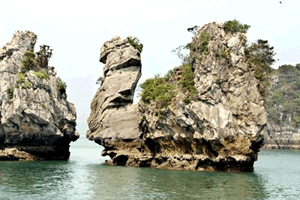
In the waters of Bai Tu Long Bay, a stone islet is bobbing like an alluring and graceful swan (Thien Nga) – a swan losing its herd. This stone swan has taken up countless time and rolls of film of tourist near and far.
Yen Ngua (Saddle) Islet
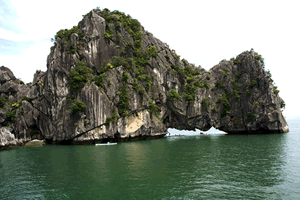 The Yen Ngua or Saddle Islet lies in Ha Long Bay, in the centre of the World Heritage Area. Nature has creatively shaped two pieces of stone, one high and one lower, which are linked together to form an imposing rock, looking like a saddle. Boats can go through underneath. The whole rock resembles a sewing machine. How wonderful to have such a magnificent but elegant “saddle”, jutting some 10 m above the sea surface.
The Yen Ngua or Saddle Islet lies in Ha Long Bay, in the centre of the World Heritage Area. Nature has creatively shaped two pieces of stone, one high and one lower, which are linked together to form an imposing rock, looking like a saddle. Boats can go through underneath. The whole rock resembles a sewing machine. How wonderful to have such a magnificent but elegant “saddle”, jutting some 10 m above the sea surface.
Ngon Tay (Finger) Islet
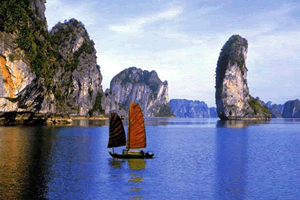 On the way to Ti Top Island, visitors see a stone rock resembling a thump jutting out of the sea. Nature has put the Ngon Tay (Finger) Islet here as a reminder of many interesting extras in the discovery of Ha Long.
On the way to Ti Top Island, visitors see a stone rock resembling a thump jutting out of the sea. Nature has put the Ngon Tay (Finger) Islet here as a reminder of many interesting extras in the discovery of Ha Long.
Mat Qui (Monster Head) Islet
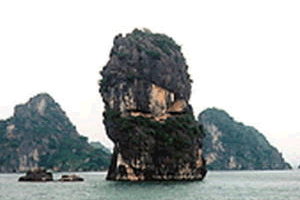 Boating past the Am Islet some 20 minutes, we see Mat Qui Islet or Monster Head Islet, which protrudes about 30-35 m from the waters of Bai Tu Long Bay. Nature has carved the rock in the shape of a monster head, with a rough big nose standing out from a distorted face. From whatever angle, one still find it horrible.
Boating past the Am Islet some 20 minutes, we see Mat Qui Islet or Monster Head Islet, which protrudes about 30-35 m from the waters of Bai Tu Long Bay. Nature has carved the rock in the shape of a monster head, with a rough big nose standing out from a distorted face. From whatever angle, one still find it horrible.
Su Tu (Sea Lion) Islet
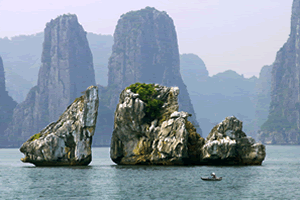 On the canoe route to Thien Cung – Dau Go Grottoes, one should visit Su Tu Bien or Sea Lion Islet, which is 10 minutes away from the Bai Chay Tourist Wharf. Amidst the vast seawaters of Ha Long, you recognize a high rock jutting from the sea, resembling a lion stretching.It attracts many French tourists because it was chosen as the background for the film L’Indochine produced by Paradis Film Company in 1992, with the famous French actress Catherine Deneuve playing a leading role. The movie focuses on a love story between a beautiful French noble woman, her adopted daughter and anti-war French lieutenant during the first Indochinese War. The main character, a young Vietnamese girl, sacrifices her love and even leaves her adopted mother behind to join the harsh resistance war and fight for national independence. In the island, some settings are still preserved including the stone-paved road to the beach (often called the Slave Pier), the prisons, etc.
On the canoe route to Thien Cung – Dau Go Grottoes, one should visit Su Tu Bien or Sea Lion Islet, which is 10 minutes away from the Bai Chay Tourist Wharf. Amidst the vast seawaters of Ha Long, you recognize a high rock jutting from the sea, resembling a lion stretching.It attracts many French tourists because it was chosen as the background for the film L’Indochine produced by Paradis Film Company in 1992, with the famous French actress Catherine Deneuve playing a leading role. The movie focuses on a love story between a beautiful French noble woman, her adopted daughter and anti-war French lieutenant during the first Indochinese War. The main character, a young Vietnamese girl, sacrifices her love and even leaves her adopted mother behind to join the harsh resistance war and fight for national independence. In the island, some settings are still preserved including the stone-paved road to the beach (often called the Slave Pier), the prisons, etc.
Cho Da Islet
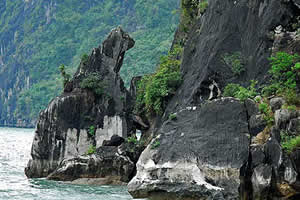 In the itinerary of Thien Cung – Dau Go – Ti Top, after visiting Thien Cung and Dau Go, one needs 10 minutes boating to the Cho Da Islet or Stone Dog Islet. Some 8 m up the islet one can figure out a piece of stone in the shape of a dog sitting with its back to the sea, standing guard for the safety of seagoing boats for millions of years.
In the itinerary of Thien Cung – Dau Go – Ti Top, after visiting Thien Cung and Dau Go, one needs 10 minutes boating to the Cho Da Islet or Stone Dog Islet. Some 8 m up the islet one can figure out a piece of stone in the shape of a dog sitting with its back to the sea, standing guard for the safety of seagoing boats for millions of years.